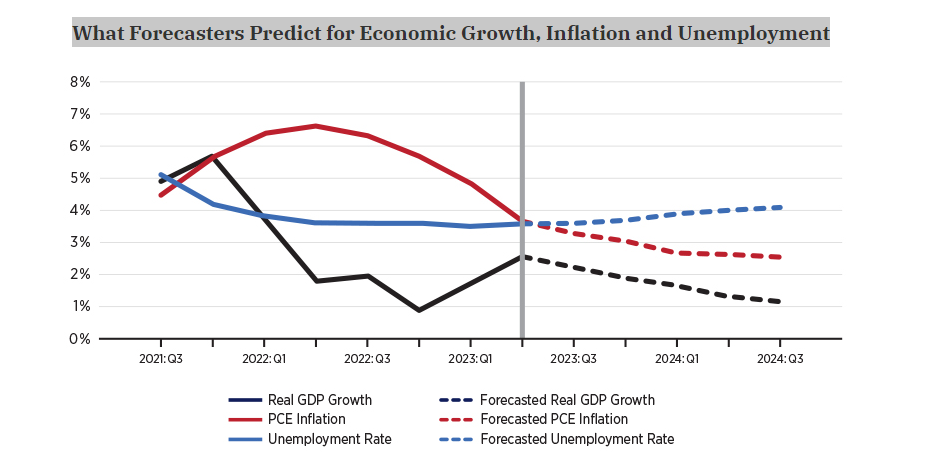Resolution Criteria: The market resolves to YES if the [real] U.S. GDP growth rate for the year 2023 exceeds 3% according to the U.S. Bureau of Economic Analysis. The data can be verified from the U.S. Bureau of Economic Analysis' official website. Otherwise, the market resolves to NO.
As the link above suggests: this is real GDP.
🏅 Top traders
| # | Name | Total profit |
|---|---|---|
| 1 | Ṁ1,256 | |
| 2 | Ṁ806 | |
| 3 | Ṁ398 | |
| 4 | Ṁ132 | |
| 5 | Ṁ111 |
People are also trading
@d No problem at all! I haven't figured out what kind of quickly-typeable comment I can leave that ensures creators don't think they're being blamed or criticised, and that it's just a note so people know why I resolved it. Let me know if you think of a good wording.
@chrisjbillington Oh no it’s okay! I just think it’s best practice to resolve my questions and thought I’d provide the reason why I didn’t :)
Final estimate is in:
Real GDP increased 2.5 percent in 2023 (from the 2022 annual level to the 2023 annual level),
Resolves NO @d
2.5% according to the advance estimate:
https://www.bea.gov/news/2024/gross-domestic-product-fourth-quarter-and-year-2023-advance-estimate
Don't know if this question resolves on the advance estimate, "second estimate" (Feb 28th) or what, but it's looking like a NO.
@chrisjbillington Something isn’t right about these numbers. Help me understand the flaw in my thinking. Q1 growth was 2.3%, q2 was 2.1%, q3 was 4.9% and q4 was 3.3%. That has got to be over 3%. These are all yearly real growth rates.
https://www.bea.gov/sites/default/files/2024-01/gdp4q23-adv.xlsx
@StanZhang that's bizarre. Could you tell me where I might read more about this? Howcome it's not just, you know, YoY GDP, like how every other YoY figure is calculated?
@chrisjbillington Here's a hypothetical example. Suppose that in year 1 quarterly GDP starts at a baseline of $1. It doubles in Q4 of year 1. The overall GDP is $1 for Q1-3 year 1, and $2 for Q4 2021. This gives a $5 GDP in Q1.
Now, suppose that quarterly GDP is flat in year 2. Then, this gives $2 per quarter in year 2, or $8 total. Even though each quarter in year 2 was flat, the overall GDP growth was 60% (from $5 to $8).
@StanZhang Ah good, I get it. In your latest comment you're literally talking about quarterly GDP itself, not growth rates, such that full-year GDP is the sum of all quarters, then YoY GDP growth at end of 2023 is just 2023 full year GDP / 2022 full year GDP - 1.
As opposed to the YoY growth rate of quarterly GDP, which would just be the four QoQ growth rates (not annualised) multipled up.
And the rough formula in your first comment contains annualised QoQ GDP growth rates?
We agree with the original commenter that the US GDP growth rate will not exceed 3% in 2023. However, the original comment provided is laced with uncertainty and appears to be a macro-economic AI-generated comment lacking in statistical inference. In our case, we have backed up our bet with the following three statistical analyses.
Firstly, there is a moderate negative correlation of -0.457 between unemployment and GDP rates from 1991-2022 in the USA. This means that the higher the unemployment rates, the more tendency for a downward trend in real GDP rates. Sadly, the unemployment rate in the U.S. today has worsened from 2.06% in 2022 to 3.7% in October 2023. Consequently, the growth rate is likely to witness a dip rather than a surge.
Secondly, performing a linear forecast for the growth rate predicts a trend line below 3.0% far into the year 2025 thereby consolidating our stance.
Finally, calculating the probability of the GDP rate exceeding the 3% mark (assuming a normal distribution with the continuous growth rate data for 2012-2022) has a 33.3% chance of happening, confirming that the US GDP growth will not exceed 3% in 2023.
Economic growth has never been stable for a long time. It is either slowing down or picking up. the forecasters expected the real GDP to reach %2.1 during the last quarter of 2023 and %1.3 in 2024 (Third Quarter 2023 Survey of Professional Forecasters, n.d.). They also expect unemployment rate to increase from %3.6 to %4 during the second three months of 2024, but all of this could change by the year of 2025 and 2026 while the unemployment rate is predicted to decrease to %3 (Third Quarter 2023 Survey of Professional Forecasters, n.d.).
All of this is a result of the economy of America that is set to a downturn due to an inflation rate of %5 (The Economist, 2023). In other meanings, this is due to the recession which is a significant decline in employment, gross domestic product, and monthly income (Ryan, n.d.). It only happens when the economy of a particular country reaches the top. As a solution for such a situation, the central bank has to provide more money to the economy so the gross domestic product is positively affected (Ryan, n.d.).
@RastyAbdulrahman Hi Ratsy, I agree with you considering the information provided, it is unlikely that the U.S. real GDP growth rate will exceed 3% in 2023. The forecasts from the Federal Reserve Bank of Philadelphia, which surveyed 37 forecasters, indicate an upward revision in near-term growth and job gains. While the predictions have improved, the panel still expects real GDP to grow at an annual rate of 1.9% this quarter, with an average growth rate of 2.1% for the entire year 2023. These figures align with the median FOMC participant's estimate of the longer-run real GDP growth rate at 1.8%.
The forecasters' projections show a cautious optimism, indicating a strengthening economy, but not at a pace that would reach or exceed the 3% threshold. The revised estimates, while higher than previous ones, suggest a moderate and steady growth trajectory rather than a rapid acceleration. Given the current economic indicators and expert opinions, it is reasonable to expect the U.S. real GDP growth rate to remain below the 3% mark in 2023.

First of all, the real GPD in 2021 was 2.1%. There are various factors contributing to GPD, such as personal consumption, business investment, interest rates, inflation rates, population growth, and workforce, but the most important factor in the United States is personal consumption, which generally accounts for 60 to 70% of the total.
Personal consumption is a main element of economic activity and has a major impact on the health of the economy. We can calculate it using an indicator called CPI.
The consumer price index (CPI) in July 2023 was up 3.3% from a year earlier, and this level is far below the rate of 8.9%, respectively, that occurred in June 2022.
Additionally, the Core Index, a price index that excludes food and energy, rose 4.7% in the 12 months to July. This core CPI measure is below its recent peak of 6.6%, which occurred in September 2022.
As a result, it can be seen that the inflation rate has subsided compared to last year. Furthermore, when looking at real GPD since 2010, 2021 was the only year in which it exceeded 3%. Real GDP in 2021 is 5.9%.
This increase reflected increases in all major components, led by PCE, nonresidential capital investment, exports, residential capital investment, and private inventory investment, which declined by 3.4% in 2020.
Given all the information, it’s hard to estimate that the U.S. real GDP growth rate exceed 3% in 2023.
Reference:
Real GDP growth rate U.S. 2022 | Statista. (2023, June 1). Statista. https://www.statista.com/statistics/188165/annual-gdp-growth-of-the-united-states-since-1990/#:~:text=In%202022%20the%20real%20gross,and%20high%20growth%20in%202021.
@8aca I agree with the conservative outlook that U.S. real GDP growth is unlikely to exceed 3% in 2023. This stance is informed by a decade's trend where such robust growth has been an anomaly, coupled with the fact that recent consumer spending increases do not suggest a significant GDP boost. The pandemic has notably shifted consumer behavior, with a $136 billion surge in durable goods spending in 2020, while service spending fell by $473 billion. As of late 2022, there's been over a 4% decline in real durable goods purchases, signaling a potential reversion to pre-pandemic norms (Bachman, 2023). Should consumers revert fully, durable goods could see a 20% spending decrease. The longevity of pandemic purchases may also dampen new durable goods spending. A refined forecast would benefit from econometric models that integrate these spending patterns with broader economic indicators, enhancing the statistical foundation of the GDP growth projection.
Reference: Bachman, D. (2023). United States Economic Forecast Q2 2023. Deloitte Insights. https://www2.deloitte.com/xe/en/insights/economy/us-economic-forecast/united-states-outlook-analysis.html
